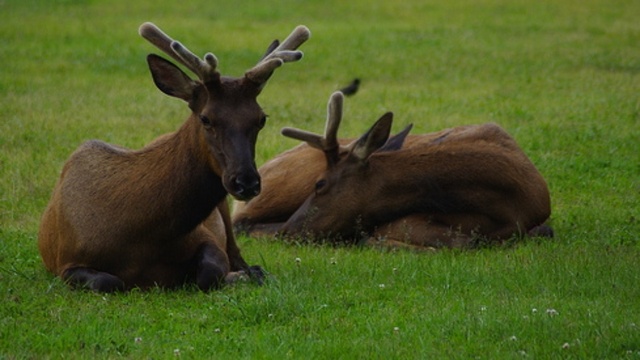
It began with a few isolated cases and is now common in herds across the region, from Vancouver to the foothills of Mount St. Helens. Hunters first spotted elk limping near Longview Washington in the 1990s. They reported the animals' hooves were deformed or missing.
Darren Sparks can see the diseased elk in his backyard in Kelso.
"You'll see, usually, half the herd have hoof rot," he says.
"They won't survive the winter. They can't get around as good and you'll see their hindquarters, start getting skinnier and skinnier."Kristin Mansfield, a veterinarian with the Washington Department of Fish and Wildlife, says the disease hasn't caused a decline in Washington's elk population yet, but it may if it continues to spread to new herds.
"To me, the biggest concern is how quickly it has spread and how severe it is in the animals."Mansfield says the disease doesn't match any other reports of elk maladies in the United States. Forms of hoof rot do appear occasionally in Wyoming's populations of elk that congregate around feeding sites. Mansfield says those reports of hoof disease are limited to winter and to a few individual animals.
"Ours is year round, and it's in a whole bunch of elk, not just a scattered few," she says.
Mansfield says the hoof disease affects up to 90 percent the elk in some herds. She says southwest Washington's wet weather could be contributing to the incidence of the disease, but believes some other factor has triggered its rapid appearance and spread.
Mansfield has ruled out viral infections and mineral deficiencies, and suspects that unknown bacteria could be causing the hoof deformities.
The Washington Department of Fish and Wildlife is working with specialists in Australia to try to pinpoint the cause of the disease, and has created a portal for members of the public to report cases of elk with deformed feet.
The portal includes a detailed set of questions, an interactive GPS map, and a field for uploading video and photos of diseased animals.
WDFW recently surveyed roughly 500 hunters in these counties in Southwest Washington to gather information on the geographical extent, and frequency, of hoof disease.
The distribution of hoof disease in Southwest Washington elk in 2009, based on the hunter surveys. The numbers on the map identify Game Management Units (GMUs). Colored areas on the map are GMUs where hunters observed limping elk; the colors show what percentage of elk observed in an area were limping. For example, in GMU 530, colored red on the map, 24 percent of the elk in the unit were limping.
According to the surveys, about half of the elk groups Southwest Washington hunters observed in 2009 contained some limping elk.



Comment: It's the second mysterious disease to affect elk population around the world recently:
Swedish experts baffled by 'mystery' elk illness